Als neue Benutzer mit WordPress anfingen, hatten viele von ihnen ein ähnliches Anliegen: Soll ich Beiträge oder Seiten für meinen Inhalt verwenden?
Wenn Sie sich darüber auch den Kopf zerbrechen, machen Sie sich keine Sorgen. Sie sind nicht allein. Es ist eine der häufigsten Fragen, die wir von neuen WordPress Benutzern erhalten.
Auf den ersten Blick sehen Beiträge und Seiten vielleicht gleich aus. Tatsächlich sind sie aber recht unterschiedlich, und die Verwendung der richtigen Seite kann Ihre Website deutlich verbessern. In diesem Leitfaden erklären wir, was Beiträge und Seiten sind, wie sie sich unterscheiden und wann man sie verwenden sollte.
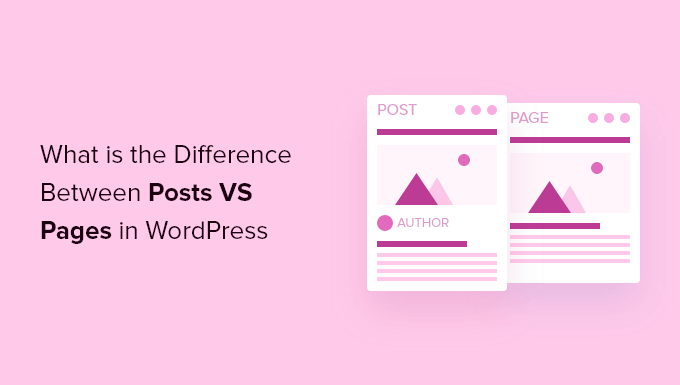
Das werden wir in unserem Artikel besprechen:
Was sind Beiträge in WordPress?
Beiträge werden verwendet, um Blog-Inhalte, Artikel und andere Inhalte zu erstellen, die auf Ihrer Blog-Seite aufgeführt werden. Sie werden in umgekehrter chronologischer Reihenfolge angezeigt, so dass der neueste Inhalt (Ihre neuesten Beiträge) ganz oben in der Liste erscheint.
Wenn Sie WordPress als Blog verwenden, werden Sie wahrscheinlich Beiträge für den Großteil des Inhalts Ihrer Website verwenden.
Sie können Ihre WordPress-Beiträge hinzufügen und bearbeiten, indem Sie auf die Menüoption “Beiträge” in Ihrem Dashboard klicken. So sieht der WordPress-Beitragseditor aus.
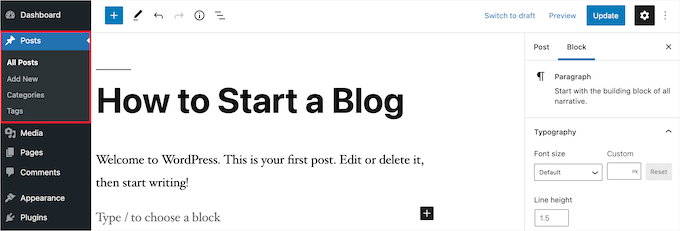
Standardmäßig werden Ihre Beiträge in der Reihenfolge vom neuesten bis zum letzten Beitrag aufgelistet. Sie können aber auch die Funktion “Hervorgehobene Beiträge” von WordPress verwenden, um einen Beitrag zu veröffentlichen, den Ihrer Meinung nach jeder lesen sollte.
Sie können Ihre Beiträge auch anhand von Kategorien und Schlagwörtern organisieren, die das Taxonomie-System von WordPress darstellen. So können Besucher verwandte Inhalte leichter finden und effektiver auf Ihrer Website navigieren.
Wenn Sie zum Beispiel einen Kochblog betreiben, könnten Sie Kategorien wie Vorspeisen, Hauptgerichte und Desserts und Schlagwörter wie Vegetarisch, Schnelle Mahlzeiten oder Urlaubsrezepte verwenden.
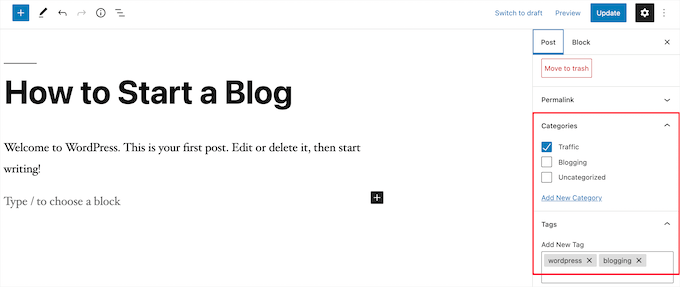
Beiträge in Blogs sind auch dazu gedacht, Gespräche anzuregen. Sie verfügen über eine eingebaute Funktion, die es Benutzern ermöglicht, Kommentare zu einem bestimmten Thema abzugeben.
Standardmäßig sind Kommentare, Pingbacks und Trackbacks aktiviert.

Sie finden den Abschnitt für Kommentare nach dem Inhalt des Blogbeitrags. Andererseits deaktiviert WordPress normalerweise Kommentare auf Ihren Seiten.
In WordPress-Beiträgen werden auch Metadaten zu den Beiträgen veröffentlicht. Diese Informationen werden nach dem Titel des Blogbeitrags in den einzelnen Beiträgen und auf Ihrer Blog-Seite aufgeführt.
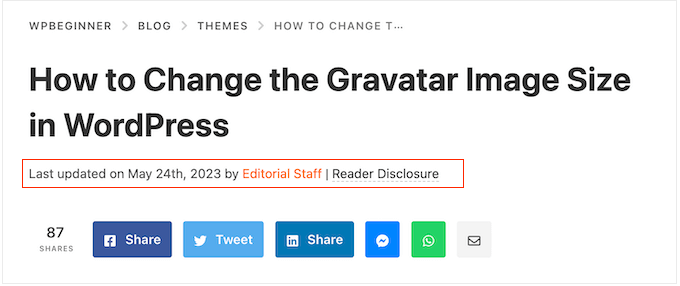
In der Regel werden das Veröffentlichungsdatum, der Name des Autors, Kategorien, Tags und mehr angezeigt. Sie können die Metadaten Ihres Beitrags vollständig anpassen. Weitere Einzelheiten finden Sie in unserem Leitfaden zur Anzeige von Blogpost-Metadaten in WordPress-Themes.
Nachdem Sie nun wissen, was WordPress-Posts sind, wollen wir uns nun die Seiten ansehen und wie sie sich unterscheiden.
Was sind Seiten in WordPress?
Seiten sind statische “einmalige” Inhalte wie die Seite “Über uns”, die Datenschutzrichtlinie, die Kontaktseite und andere. Während die WordPress-Datenbank das Veröffentlichungsdatum der Seite speichert, sind Seiten zeitlose Einheiten.
Ihre Info-Seite hat zum Beispiel kein Verfallsdatum. Sicher, Sie können zurückgehen und sie aktualisieren, aber die Chancen stehen gut, dass Sie keine Über-Seite 2012, Über-Seite 2013 usw. haben werden.
Wir haben alle Arten von statischen Seiten auf WPBeginner, wie z.B. unsere Homepage, die Seite “Start here “, die Seite “About”, die Kontaktseite, die Archivseite und benutzerdefinierte Seiten, wie z.B. unsere Seite für kostenlose Business-Tools.
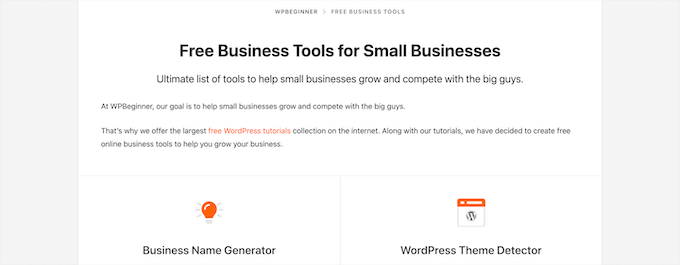
Sie können Seiten in Ihrem WordPress-Administrationsbereich hinzufügen und bearbeiten, indem Sie auf die Menüoption “Seiten” klicken.
So sieht der Bildschirm des Seiteneditors aus.
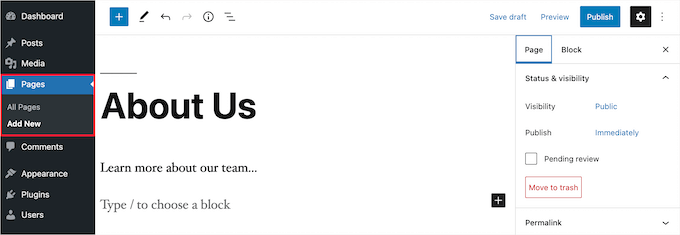
Seiten sind nicht für soziale Netzwerke gedacht, daher haben sie in der Regel keine Schaltflächen für die gemeinsame Nutzung. Zum Beispiel möchten Sie wahrscheinlich nicht, dass Besucher Ihre Seite mit den Datenschutzbestimmungen auf Twitter teilen.
Die Seiten enthalten auch keine Kommentare. Sie möchten nicht, dass die Nutzer Ihr Kontaktformular oder Ihre Nutzungsbedingungen kommentieren. Es gibt eine Option zum Aktivieren von Kommentaren. Sie ist jedoch standardmäßig für Ihre WordPress-Seiten deaktiviert.
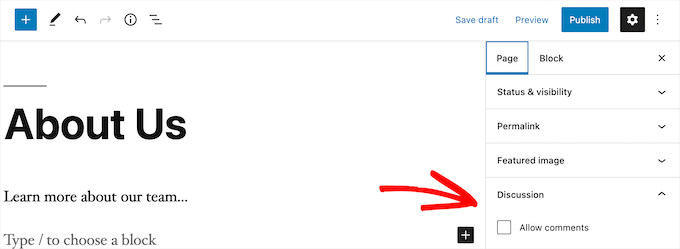
Anders als Beiträge sind Seiten von Natur aus hierarchisch aufgebaut. Sie können zum Beispiel Unterseiten oder untergeordnete Seiten innerhalb einer Seite haben.
Sie können eine Seite ganz einfach in eine Unterseite umwandeln, indem Sie bei der Bearbeitung einer Seite eine übergeordnete Seite aus dem Abschnitt “Seitenattribute” auswählen.
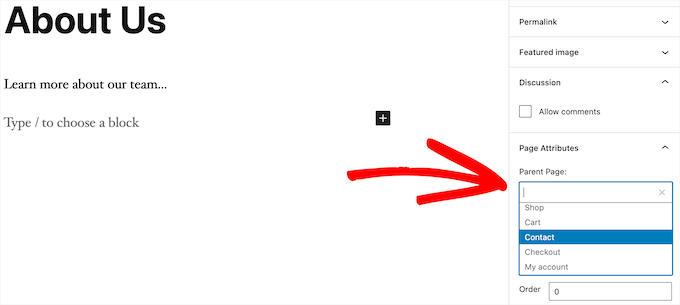
Außerdem können Sie mit Hilfe eines Drag-and-drop-Plugins für den WordPress Page-Builder komplett individuelle Seiten für WordPress erstellen. Damit können Sie andere Seiten-Layouts als die von WordPress bereitgestellte Standard Option verwenden.
Weitere Einzelheiten finden Sie in unserer Anleitung zum Erstellen einer benutzerdefinierten Seite in WordPress.
WordPress-Seiten vs. Beiträge (Hauptunterschiede)
Ein Beitrag ist für Inhalte gedacht, die Sie regelmäßig veröffentlichen, wie Blogbeiträge und Nachrichtenartikel. Eine Seite hingegen ist für statische Inhalte gedacht, die nicht so häufig aktualisiert werden, wie z. B. eine Homepage, eine Info-Seite, eine Kontaktseite usw.
Hier sind weitere wichtige Unterschiede zwischen Beiträgen und Seiten in WordPress:
- Die Beiträge sind zeitgemäß, die Seiten zeitlos.
- Sie können Kategorien und Tags verwenden, um Beiträge zu organisieren, während Seiten hierarchisch und als untergeordnete und übergeordnete Seiten organisiert sind.
- Beiträge haben einen Autor und ein Veröffentlichungsdatum, während Seiten dies nicht haben.
Trotz dieser Unterschiede gibt es einige Ähnlichkeiten zwischen Seiten und Beiträgen in WordPress.
Erstens werden beide für die Veröffentlichung von Inhalten verwendet. Sie können sowohl zu Beiträgen als auch zu Seiten Text, Bilder, Videos, Formulare und mehr hinzufügen. Sowohl auf Seiten als auch in Beiträgen gibt es Unterstützung für Bilder.
Sie können eine WordPress-Website erstellen, ohne jemals Beiträge oder die Blogging-Funktionen von WordPress zu verwenden. Sie können auch eine geschäftliche Website mit Seiten und einem separaten Blog-Abschnitt für Ihre Nachrichten, Ankündigungen und andere Artikel erstellen.
Beiträge vs. Seiten: Häufig gestellte Fragen (FAQs)
Nachfolgend finden Sie einige der am häufigsten gestellten Fragen, die wir von unseren Nutzern über Posts und Seiten und deren richtige Verwendung in WordPress gehört haben.
Wie viele Beiträge und/oder Seiten kann ich in WordPress haben?
Sie können so viele Beiträge und/oder Seiten erstellen, wie Sie möchten. Es gibt keine Begrenzung für die Anzahl der Beiträge oder Seiten, die erstellt werden können.
Gibt es irgendwelche SEO-Vorteile für Beiträge im Vergleich zu Seiten?
Nicht ganz. Im Allgemeinen mögen Suchmaschinen immergrüne Inhalte, die organisiert und aktuell sind. Es gibt auch Tools wie AIOSEO, die Ihnen dabei helfen, sowohl Blogbeiträge als auch Seiten zu optimieren, damit beide auf den Ergebnisseiten der Suchmaschinen erscheinen können.
Alles in allem empfehlen wir, Ihre Bemühungen darauf zu konzentrieren, Ihre Website benutzerfreundlich und für Ihre Zielgruppe wertvoll zu gestalten. Weitere Informationen finden Sie in unserem ultimativen WordPress-SEO-Leitfaden für Anfänger.
Ist das Hinzufügen von Seiten ähnlich wie das Hinzufügen von Beiträgen in WordPress?
Ja. Das Menü zum Hinzufügen von Seiten und Beiträgen in WordPress ist zwar getrennt, aber der Prozess zum Erstellen eines neuen Beitrags und einer neuen Seite ist ähnlich.
Für Seiten können Sie im WordPress-Verwaltungsbereich auf Seiten “ Neu hinzufügen gehen. In der Zwischenzeit können Sie einen neuen Beitrag erstellen, indem Sie auf Beiträge ” Neu hinzufügen gehen. In beiden Fällen werden Sie dann zum Gutenberg-Editor weitergeleitet, um Ihre Inhaltsblöcke hinzuzufügen.
Welche Seiten sollte ich auf meiner Website oder meinem Blog erstellen?
Das hängt davon ab, welche Art von Blog oder WordPress-Website Sie erstellen. Sie können sich aber auch unsere Liste der wichtigen Seiten für alle Websites ansehen.
Kann ich Beiträge in Seiten umwandeln und umgekehrt?
Viele Anfänger fügen versehentlich Inhalte zu Beiträgen hinzu, wenn sie Seiten erstellen wollen. Ebenso kann es vorkommen, dass neue Blogger ihre Blogbeiträge als Seiten speichern.
Wenn Sie gerade erst anfangen, können Sie das mit dem Plugin Post Type Switcher leicht beheben. Weitere Details finden Sie in unserer Anleitung zum Wechseln von Beitragstypen in WordPress.
Gibt es neben Beiträgen und Seiten noch andere Inhaltstypen in WordPress?
Ja, die gibt es. Zu diesen anderen Standardinhaltstypen gehören Anhänge, Revisionen und Navigationsmenüs. Sie werden jedoch nicht auf dieselbe Weise verwendet wie Beiträge und Seiten.
Mit WordPress können Sie auch Ihre eigenen benutzerdefinierten Beitragstypen erstellen. Diese Funktion wird von Plugins genutzt, um zusätzliche Inhaltstypen in WordPress zu erstellen.
Wenn Sie beispielsweise ein Online-Geschäft mit WooCommerce betreiben, sehen Sie in Ihrem WordPress-Verwaltungsbereich den Beitragstyp “Produkte”.
Weitere Einzelheiten finden Sie in unserer Schritt-für-Schritt-Anleitung zum Erstellen benutzerdefinierter Beitragstypen in WordPress.
Wir hoffen, dass dieser Beitrag Ihnen geholfen hat, den Unterschied zwischen Seiten und Beiträgen in WordPress zu verstehen und zu verstehen, wie man sie verwendet. Vielleicht interessieren Sie sich auch für unsere Tutorials über die Unterschiede zwischen einer Landing Page und einer Website und die besten Plugins für beliebte Beiträge in WordPress.
Wenn Ihnen dieser Artikel gefallen hat, dann abonnieren Sie bitte unseren YouTube-Kanal für WordPress-Videotutorials. Sie können uns auch auf Twitter und Facebook finden.





Ian
I believe I am correct in saying that you use pages here?
Surely most websites supporting a business or running as a business would be pages?
For a news site I can understand posts – but should these all be in one root folder or divided into years?
Do having years, just shout WordPress to anyone browsing?
WPBeginner Support
We use posts for most of our content on this site and have a few pages. You do not need to worry about placing the posts into folders as posts are automatically set in chronological order.
Admin
Paul
I am blessed to have stumbled upon your site when I was searching for WordPress help. This is an excellent resource. Thank you.
WPBeginner Support
You’re welcome, glad our guides have been helpful!
Admin
Ashok Singh
Hello, I have created multiple pages but whenever I am writing any post it shows on my home page as a recent post but I also want visible the same post on another page. How can i do it ?
WPBeginner Support
To show recent posts, you would want to take a look at our article below!
https://wpbeginner.com/wp-tutorials/how-to-display-recent-posts-in-wordpress/
Admin
Dev Patel
So with a worpress post, I can create as many blogs/articles I want that will be available to be viewed to the public without having to purchase new domains?
WPBeginner Support
Yes, there is not a cost to create a post on WordPress unless you have enough posts that you are running out of server space on your hosting provider in which case you would want to look to upgrade your hosting
Admin
Bhavana
Thanks for making it so easy to understand. Great Post.
WPBeginner Support
You’re welcome! Glad you found our post helpful!
Admin
Arun
Hi,
I have a website that provides users some tools like json to xml convertor, random name generator etc. so is it good to have them inside a page or posts?
WPBeginner Support
For static content and tools like that, we would normally recommend placing them on a page.
Admin
Gill
Thank you for the great information….
WPBeginner Support
You’re welcome!
Admin
Simy Khera
hey, I have a question that for blogging what is needed a post or page ? and do ever website who have about us is a page or it can be a blog too?
WPBeginner Support
Most blogs use posts instead of pages for most of their content and for a majority of sites the about us would be a page but there’s nothing wrong with testing if having it as a post works for your site.
Admin
Tuomas
Hello,
Thank you for this guide. I have made such “mistake” on our business website that I have created my blog archive just as a normal page and same with our blog posts: pages instead of posts. As changing this would demand a lot of work, I’m probably not going to change this. Would you happen to know, how I can create an RSS feed for pages instead of posts?
WPBeginner Support
To make swapping easier, you may want to try the recommended plugin in our article below:
https://www.wpbeginner.com/plugins/how-to-convert-post-types/
We do not have a recommended method for RSS for pages at the moment.
Admin
Lalit Singh Chauhan
Great Information.
I am using newspaper theme and for some reason my Page posts are totally different than the default blog posts template. What could be the reason?
WPBeginner Support
Your theme may have specific styling for the different pages/posts. You would want to check with your theme’s support to see if that is the reason.
Admin
Martin
Great article. I just started out and have the latest update.
But I don’t seem to get it working as I want.
WPBeginner Support
For site specific support we would ask that you reach out to us using our contact form as your question would require asking additional information that would not fit our comment policy.
Thanks
Admin
Vinit
How can I change footer on Post? Footer on my website pages is coming different then the Blog Post. Please help.
WPBeginner Support
That would be determined by your specific theme. If you reach out to your theme’s support they should be able to assist.
Admin
Melchi
Can I use pages as a posts.
And also can I use pages as a blog post.
WPBeginner Support
While you can, using posts would give you more tools for your content to be found by your users.
Admin
Nicolas
What about where a page is generally the same but your content may vary 100s of times (Like recipees or products in a shop like Amazon for example) It’s not a static page and yet it’s not a post, it’s something in between
WPBeginner Support
It sounds like you mean custom post types which we cover in our glossary here: https://www.wpbeginner.com/glossary/post-types/
Admin
Spenser
Great stuff. Just starting out with WP and this is exactly what I need. Many useful links to other, equally useful, posts (or are they pages? – only kidding). Really useful site – I have emailed myself the URL. Many thanks – please keep up the good work.
PS – never left comments on a WP site before – so interested in seeing how this works.
WPBeginner Support
Glad you like our content
Admin
dimarifi
Thanks for this helpfull guid.
But I have a question, for exemple this webpage : https://www.wpbeginner.com/category/beginners-guide/ its post or page?
Thanks
WPBeginner Support
That is an archive page, we’ve linked directly to the category and it is showing the archive for beginners guides which is styled the same as our posts page.
Admin
Acha Mercy
thanks for clarifying me on this
WPBeginner Support
You’re welcome
Admin
Mjkoroma
Hello, will I be able to use a website as both a blog and a ‘website’ simultaneously?
I mean, if I would use pages and posts on a website, simultaneously…
WPBeginner Support
You can certainly use those features together. We have an article that should help clear up some confusion here: https://www.wpbeginner.com/beginners-guide/what-is-a-blog-and-how-is-it-different-from-a-website-explained/
Admin
Billy
PRODUCT PAGE: POSTS OR PAGES?
WPBeginner Support
That varies from one plugin to another, it is normally a page listing a custom post type if I understand what you’re asking correctly.
Admin
joljols
I was wondering if the articles on wpbeginner are posts or pages as they have a page-like url but most features of a blog post. Also, many of the articles are often updated over time to keep the contents of the article up to date. How do you deal with those updates and making sure readers know about them? The reason I am asking is because I am also writing a list of articles with coding tips/tutorials and am wondering if I should write them as posts or pages on my wordpress site. I hope you can give me advice!
WPBeginner Support
Hi,
We use posts to publish most of our articles.
Admin
Charles
Doesn’t that mean, we should always use Pages if we want a unique design for the mega content we are going to create?
Otherwise, post seems to have a lot of limitation of how the overall content visual to be structured.
Stephanie
I have to translate my content across multiple languages – so my current blog is being housed in pages vs posts. If I move my blog over to posts – can i translate that out?
WPBeginner Support
Hi Stephanie,
You can translate your WordPress content by using a WordPress multilingual plugin.
Admin
Bruce
Hello and thanks for the great site. I’ve been running some WP sites for a few years and I always come to WPBeginner for quality and concise information.
The sites I’ve built have been fine with static pages but one client (my wife) wants to add a blog to her martial arts site.
How do we make something that looks like the blog page on this site?
I understand how to create the post, and can add it to a menu, but do not know how to make a page with the chronological list of posts.
Is this a feature of the specific theme? I am using Genesis and Responsive.
Thanks again, I’m sure there’s an obvious solution that I’m overlooking.
WPBeginner Support
Hi Bruce,
Please see our guide on how to create a separate page for blog posts in WordPress.
Admin
Cherian
I’m not sure i was doing wrong. Please help.
On my website, im publishing the same topic as Post and page (So two URLs has same topic, 1 page and 1 posts).
Any issues on that? or do i need to remove one of them? Thanks.
Denish Callos
Hi,
I have been using wordpress for web development for a while now. I am starting a new tutorial site in wordpress. I am confused in writing tutorials as pages or posts. Number of tutorials wil be huge. So should i publish tutorials as posts or pages.(please suggest me on this). And how do i include category name in permalink of pages
Suggestions will be highly appreciated.
Many Thanks
Riana
I have a smiliar question. Waiting for this to be answered.
Seems like no one has answered you yet so I’ll make my own decision based on the article.
I would like each of my tutorials to be shared on social media and accept comments which would lead me to posts instead of pages.
However, my tutorials cover many different themes and I feel like having a category list to the side with 5 billion different links will be a bit much. I also don’t like that they will be time and date stamped because they really aren’t blog posts but permanent pages on my site that most likely will never be changed or replicated.
I guess I’ll just suck it up and go with posts.
Pogo
I say definitely use posts, and I’m almost certain that you can fill pages with certain types of posts to categorize them using the hierarchy of pages.
Zachary
Use a custom post type. Setup a custom post type for your Tutorials, specifically. That is the best setup, as it is clean and keeps your blog posts sepearate. Pages are absolutely inferior in this use case, and most use cases. A good plugin for this is CPT UI (free). That mixed with Advanced Custom Fields offers an incredible amount of customization and efficiency if used correctly.
As for the many category issue. I recommend reading some guides on categories/tags. Ideally, your categories should be few and broad, while your tags are many. With ACF you can create new “category” type lists if needed, often not needed though.
You can also depend on sub-categories a lot. Having very broad parent categories, with their many child categories beneath. Show the user only the child categories for their selected main category and they won’t have a large list to deal with. When they see the initial tutorial page you show them the parent categories only. There are many ways of achieving a user-friendly design through this.
Susan Cunningham
I’m building a website with more or less timeless content. Definitely not a blog with dates, etc.. So I could dispense with Posts altogether? I have put Pages on the top running menu bar. Each Page will have a bunch of sub-pages and those can have sub-pages (grandchild pages?). Which will also dictate the URLs, right? From the reply to the previous question, I gather the downside to that is that Pages can’t be labeled with categories? Downside of using Posts,however, is that they can’t be grouped and sub-grouped under a Page?
In the past few days I’ve been wondering if those general content descriptors on the menu bar should be categories instead of Pages. This reply to the previous question seems to point in that direction: “Another way to do that is by creating templates for your categories.” But no … I’m going to have a mammoth informational/magazine type site and that would extremely limit the number of categories, seems to me. Maybe that wouldn’t matter if the number of tags was kept limited, however.
I’m not totally new to WordPress, since I use Wordpess.com for a simple personal portfolio type site. So category name(s) will appear–usually on the top left corner–of a post. But they won’t appear at all on a Page?
Whew! Sorry to sound so confusing. (Well, obviously, I’m confused!). Can you just answer the first question: Can I dispense with Posts altogether? What are the disadvantages and advantages of that?
I can’t be the first person with this question in mind. Thanks!
WPBeginner Support
Hi Susan,
You can dispense posts altogether and use pages with child pages to organize your site’s structure. You can add categories and tags to pages, if you want.
Admin
Terry Yarham
From my static home page, there are blog post categories in the menu across the top. Can I pin content to the top of the category archive page? Regular pinning isn’t working for that.
I have a lifestyle blog for my city. When someone goes to a category from the top menu (food, drink, shopping, etc.) I want them to see a short description (that will always be at the top), then see the blog posts that fall into that category as they scroll down.
Is there a way to do that? I’m using the Bento theme.
I’m game to change the categories across the top to pages so the content I want to always be seen would be there, but would I be able to get the posts to show up underneath?
Thanks for any help I can get.
WPBeginner Support
Hey Terry,
There are multiple ways to do that. For example, you can add the content you want to be displayed as category descriptions. Another way to do that is by creating templates for your categories. You can add them by simply naming the file category-{category-slug}.php like category-news.php.
Admin
Julie Gilmer
I’m trying to organize a blog of my trips with pages for each day and pictures associated with those pages. Is this possible in WordPress?
WPBeginner Support
Hey Julie,
Yes. In fact many travel writers use WordPress to share their journeys with photos, galleries, videos, text, and more. Check out our guide on how to start a WordPress blog for step by step instructions on how to get started.
Admin
Mathew
Thanks I have just been cleared!
Civali
I confess I´m pretty confused about it. I actually don´t know deal with categories in a post.
WPBeginner Support
Hi Civali,
Please take a look at our guide on the difference between categories and tags. It will help you understand how to use categories for your posts.
Admin
Bastian
I wonder how to organize content like episode guides for a TV show (that has been broadcasted years ago) with a kind of scientific interpretation of it. I think it’s very much timeless content, since it’s no actual show anymore and I don’t want to have comments on it. It should be the definitive article on the net to the subject.
So, should I write my big episode guide with plot and interpretation as a page and just put a post on my blog like “new episode guide for show – episode x season y” with a link to the page?
I have to admit it was hard to decide against a wiki because I don’t think I have timely content. But a blog seems to be more like a reflection of my personal opinion and more conversational and entertaining than a “dry” wiki text.
WPBeginner Support
Hi Bastian,
There are plenty of ways to organize this in WordPress. For example, you can Use categories for each season, and create a new post for each episode in that season.
You can use tags to assign different characters, topics, and themes that came up during that particular episode.
You can also create a custom post type.
Admin
Bastian
Thank you very much. Sounds interesting.
Somehow I think it just doesn’t feel right to use pages for articles. All the fine features like widgets, sharing etc. have to be added through plugins while posts have it all embedded. ATM I tend to use posts, because it just feels right. It feels like the way, WordPress should be used.
What I like on Pages in a strange way is, that all these distractions like widgets, sharing etc. are missing. The content area is wider (in my current theme), so for now: I start using posts but not sure if it will always stay this way. I will just have an open mind and keep experimenting. Time will tell.